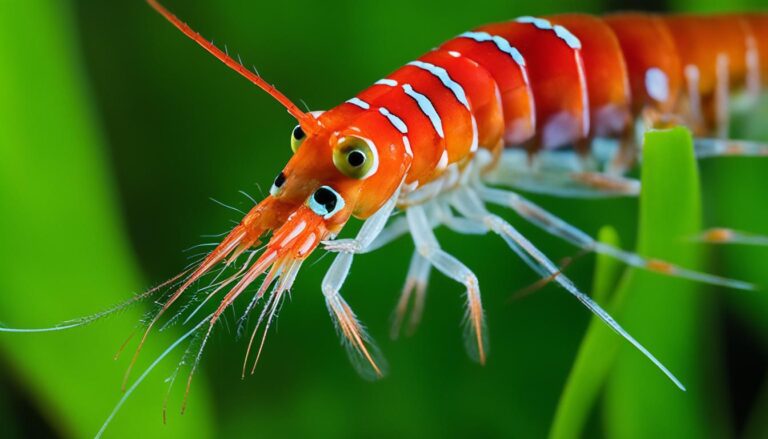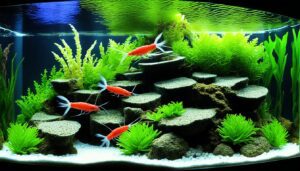In the calm waters of Sulawesi Island, Indonesia, lives a small, colorful creature—the Sulawesi shrimp. Despite being only up to 1 inch in size, these shrimp have made a big impact on the aquarium trade. They were discovered in 2007, adding brightness and curiosity to tanks worldwide. Their care is intricate, drawing interest from hobbyists globally.
As someone who loves aquariums, I find caring for shrimp like the Sulawesi fascinating. These shrimp, which live up to two years, need special attention, especially during breeding. They lay about 15 eggs. It’s a careful mix of keeping water conditions perfect and fostering a healthy environment for them.
The Sulawesi shrimp are popular for their vibrant colors and lively nature. Yet, caring for them can be intimidating at first. For those looking to keep these captive bred shrimp, remember, they have precise needs. This includes their habitat and what they eat.
Keeping the water temperature between 78°-88°F and the pH at 7.8–8.2 is key for these freshwater shrimp species. If you’re new to caring for Sulawesi shrimp, get ready for a challenge. You’ll need to do weekly water changes and monitor minerals closely. But, the beautiful colors and actions of these shrimp make it all worthwhile.
Introduction to Sulawesi Shrimp
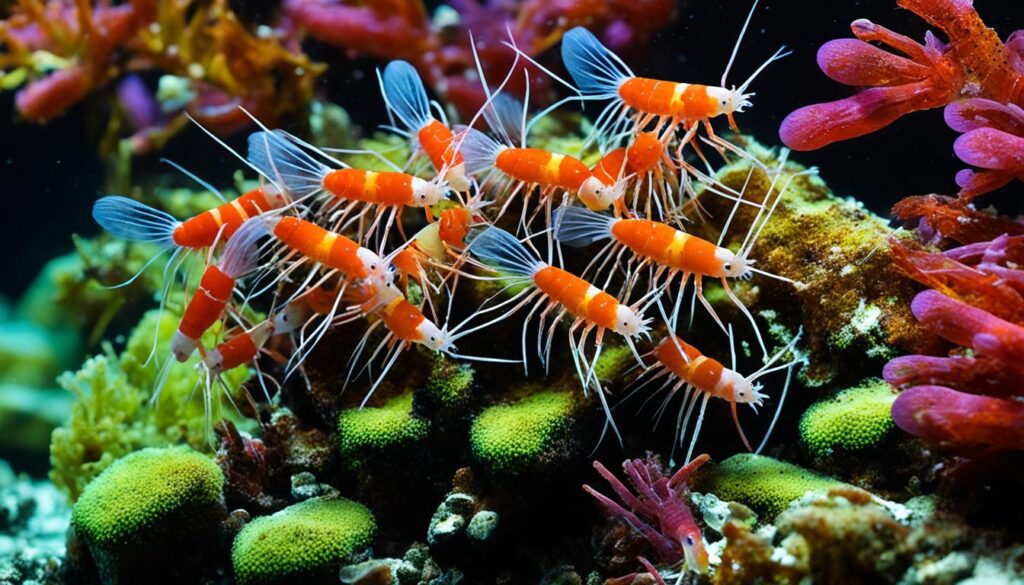
I’ve always been drawn to the beauty of Sulawesi shrimp, or white glove shrimp. Their real name is Caridina dennerli. They come from the warm waters of Indonesia, living in Lake Matano on Sulawesi Island. This place is full of life.
The care these shrimp need is more than just feeding and cleaning. Their bright colors and how they act is fascinating. But keeping them healthy takes work. They need the right conditions to live, just like their natural home. This means dealing with threats like pollution and invasive species.
Here’s what I found works best for keeping Sulawesi shrimp happy:
- They like their water around 28°C, just like their tropical home.
- The water’s pH should be between 8.0 and 8.2, with a conductivity of about 300µS/cm.
- Changing 10% of the water every week keeps their environment clean. Plus, adding certain minerals makes their colors pop and keeps them healthy.
Feeding them involves giving them what they naturally eat. My go-to food recipe is simple:
I dissolve 1ml of powdered shrimp food in 50ml of water. Then, I give it to the shrimp every couple of days. This matches their natural diet and provides all the nutrients they need.
Factor |
Specification |
|---|---|
Water Temperature |
27°C |
pH Level |
8.50 |
General Hardness (GH) |
4-8° |
Carbonate Hardness (KH) |
3-5° |
Mineral Mix |
33% each of Salty Shrimp, Prism, Alxyon |
Caring for these shrimp the right way can make them live longer and breed better. I use UVC purifiers and special bacteria in my tanks. This makes their home like their natural lake. It helps them do more than just survive.
If you’re interested in keeping Sulawesi shrimp, it’s a big responsibility. But it’s very rewarding to see them grow and thrive. These tiny creatures show the wonder of nature right in your aquarium. They’re more than pets; they’re a glimpse into a complex and beautiful world.
The Stunning Varieties of Sulawesi Shrimp and Their Characteristics
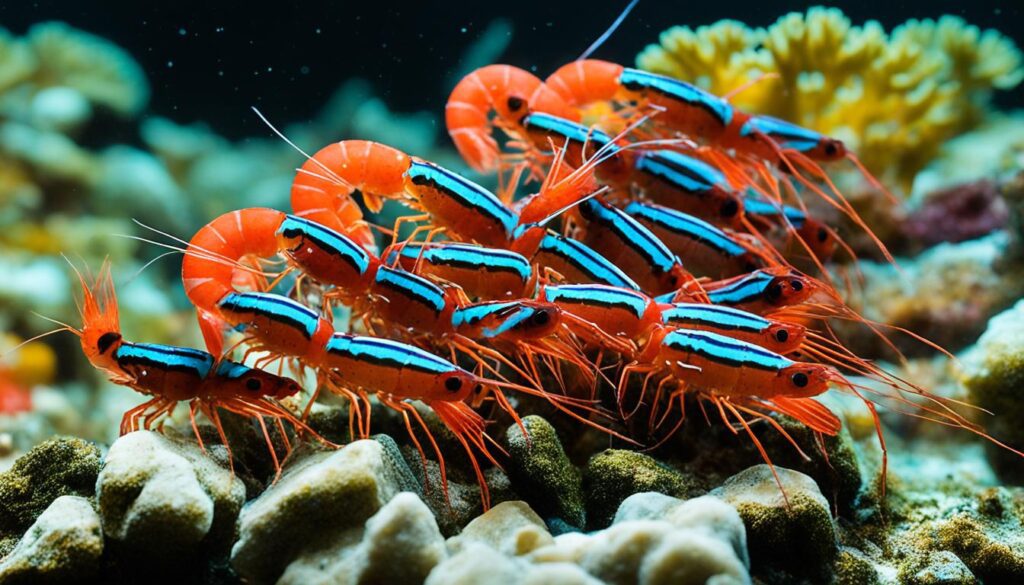
Diving into the colorful world of Sulawesi shrimp is an adventure. These shrimp come from Sulawesi, Indonesia’s clean waters. They have various colors and patterns, beloved by aquarium fans. Let’s look into their different types and special features.
Identifying Different Sulawesi Shrimp Varieties
In Sulawesi, many unique shrimp species exist. Each has fascinating traits. The Cardinal Sulawesi shrimp is known for its bright red body and white spots. It’s a real eye-catcher. The Blue Ghost shrimp impresses with its rich blue colors and dark accents. The Tigris shrimp has striking stripes, in red-and-white or brown-and-white. They remind one of a tiger’s stripes.
Also, there’s the Galaxy shrimp. It shines with a dark body and spots of white or light blue, like a night sky full of stars.
Selective Breeding and Color Patterns
Selective breeding has made Sulawesi shrimp’s colors more vivid. This has increased their beauty and the variety within the species. For example, the Galaxy shrimp now shows brighter, star-like patterns thanks to breeding efforts. Their unique coloration, with spots instead of bands, makes them stand out from other freshwater shrimp. This breeding ensures each shrimp has a distinct, bright pattern, making aquariums even more beautiful.
Looking into Sulawesi shrimp’s world shows they are more than just pets. They are living art. Their bright colors and patterns show nature’s creativity and what can happen when people add their touch. For anyone in the aquarium hobby, Sulawesi shrimp bring joy and wonder.
Creating the Ideal Habitat for Sulawesi Shrimp

To successfully care for Sulawesi shrimp, creating the perfect shrimp tank setup and planted aquarium is key. These captivating creatures thrive in environments similar to their native Sulawesi habitat.
Start by selecting the right tank. Sulawesi shrimp do well in at least 30-liter tanks, but 60 liters is better for stable conditions. The choice of substrate, like crushed black lava rock or Seachem Onyx, supports both the look of the tank and the needed water chemistry.
- Temperature control is crucial, with a preferred range of 27-29°C.
- Ammonia and Nitrite need to be kept at 0 ppm, with Nitrates less than 20 ppm.
- The general hardness should be between 6-8 dGH, and the pH should remain stable between 7.8-8.2.
When setting up a planted aquarium, choose high-temperature tolerant plants. Java Fern and Anubias are ideal, as they are both beautiful and low-maintenance. Add rocks and driftwood to mimic the Sulawesi habitat and help shrimp feed.
Water quality is crucial for their well-being. Avoid tap water because of its chemicals. Use reverse osmosis water instead, and add minerals for Sulawesi shrimp. This replicates their natural lake conditions, promoting health and color.
Be mindful when choosing tank mates. Sulawesi shrimp are peaceful and need similar, non-aggressive companions. This ensures a stress-free environment for your shrimp.
Proper shrimp tank setup and planted aquarium care let Sulawesi shrimp thrive. By mimicking their Sulawesi habitat, they’ll show off their vibrant colors and unique behaviors beautifully.
Understanding Sulawesi Shrimp Water Parameters
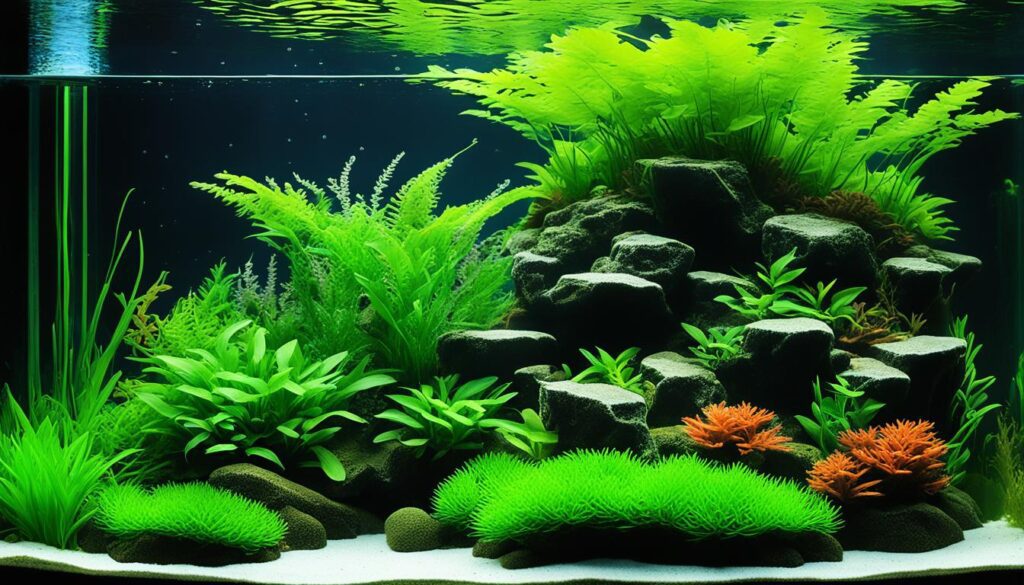
Keeping the water quality excellent is key for Sulawesi shrimp’s health. You must monitor tank temperature, pH levels, and mineral balance. These steps are crucial to copy their original home in Lake Matano.
Optimal Temperature and pH for Sulawesi Shrimp
Sulawesi shrimp thrive at a tank temperature of 77°F to 84°F. The best temperature is around 82°F. This range imitates the warm tropical shrimp conditions they come from. pH levels should stay between 7.8 and 8.2. This creates a setting that’s ideal for their well-being.
Keeping the right temperature and pH is essential. It lowers stress and boosts the shrimp’s immune system.
Water Hardness and Mineral Balance
To match the Sulawesi lakes’ mineral-rich waters, aim for a water hardness of 6 to 8 dGH. Use mineral supplements like Salty Shrimp Sulawesi Mineral 8.5. These supplements help reach the right hardness and supply vital minerals.
Always check these levels to ensure your tank resembles the tropical shrimp conditions. This is important for keeping Sulawesi shrimp healthy.
Parameter |
Ideal Range |
Products |
|---|---|---|
pH Levels |
7.8 – 8.2 |
Salty Shrimp Sulawesi Mineral 8.5 |
Tank Temperature |
77°F – 84°F |
Adjustable Aquarium Heater |
General Hardness (GH) |
6-8 dGH |
Prism Shrimp Minerals – Rock Flour Sula |
Knowing and managing these water parameters is vital for Sulawesi shrimp’s well-being. By carefully monitoring and adjusting your tank, you create a perfect home. Such an environment will closely imitate their natural habitat. It helps these unique creatures thrive and live longer. You can learn more about caring for Sulawesi shrimp by visiting this site.
Sulawesi Shrimp Diet: Optimal Nutrition and Feeding Practices
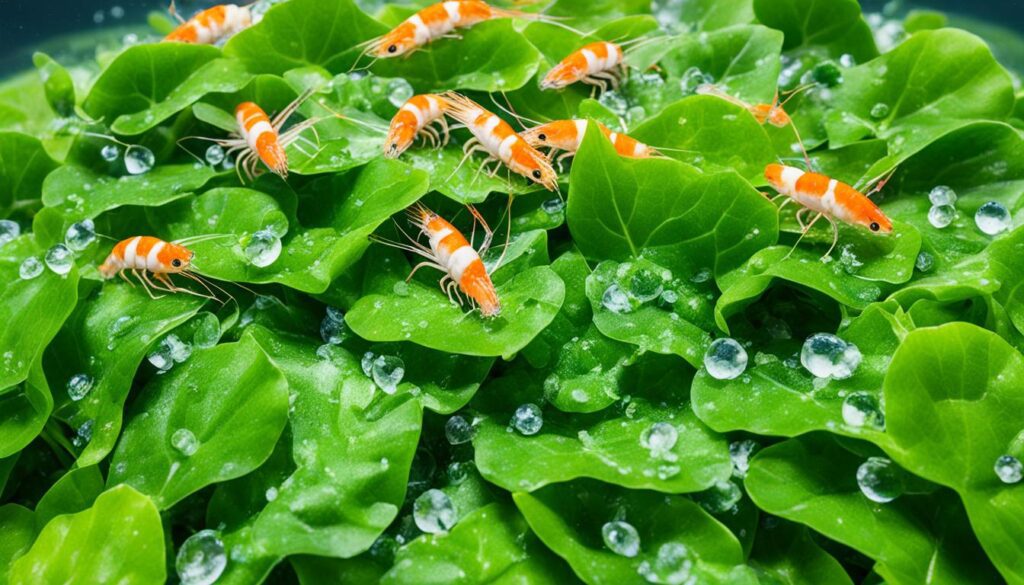
Keeping Sulawesi shrimp healthy and vibrant starts with knowing what they eat. Biofilm and algae are main parts of their diet. These shrimp, though opportunistic feeders in the wild, need a balanced diet in captivity. This balance is crucial for their growth and shell health.
It’s good to make their tank similar to their natural habitat. Include natural food sources like biofilm and algae. These not only feed the shrimp but also help balance the tank’s ecosystem. Sometimes, natural food might not be enough, especially if the tank is crowded. Then, supplemental feeding is needed.
Choose supplemental foods that are nutritious but low in protein. Too much protein can harm water quality by raising ammonia levels. Options include powdered Bacter AE, spirulina, and some blanched veggies like spinach and zucchini. These foods offer vital nutrients, aid digestion, and promote good health.
How you feed them is as important as what you feed them. I suggest using a syringe for powdered foods. This way, you can give the right amount — about 1ml per 500 shrimps every two or three days. Controlled feeding prevents overfeeding and keeps the water clean, important for shrimp health and lifespan.
Adding dried botanicals like lotus pods and cholla wood is beneficial too. They boost biofilm growth, giving shrimp a constant natural food source. Sometimes, give shrimp lollies—they’re a treat with algae and powdered food. They add variety to their diet and nutrition.
Always remove uneaten food after two hours to avoid water issues. Keep an eye on how much you feed and adjust as needed. This ensures a great environment for Sulawesi shrimp.
- Maintain a biofilm and algae-rich environment
- Supplement with high-quality, low-protein powdered foods
- Use precise feeding methods to avoid overfeeding
- Incorporate botanicals to enhance biofilm growth
- Periodically treat with shrimp lollies for nutritional variety
- Remove uneaten food promptly to maintain water quality
By following these feeding guidelines, aquarists can give their Sulawesi shrimp the right nutrition. This keeps them healthy, long-lived, and colorful.
Breeding Sulawesi Shrimp: Tips and Techniques
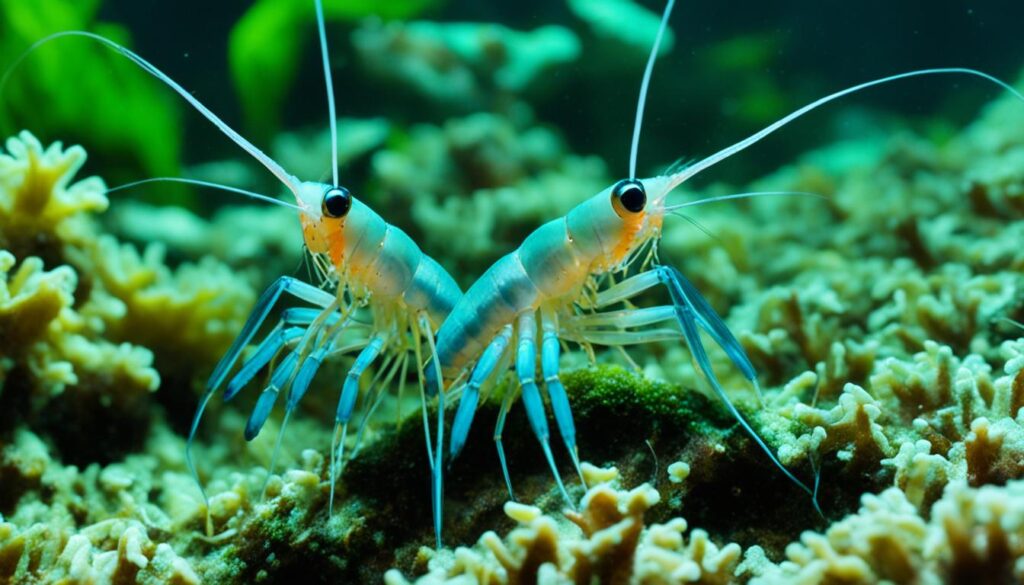
If you’re into breeding Sulawesi shrimp, getting their breeding conditions right is key. These shrimp have a unique way of reproducing, with about 15 eggs per brood. The eggs take around 20 days to hatch, so precise conditions are crucial for success.
Understanding Breeding Patterns of Sulawesi Shrimp
Breeding Sulawesi shrimp is fascinating. Their breeding cycles depend a lot on their environment. To breed them well, your tank needs to feel like their natural habitat. This includes keeping the water’s Total Dissolved Solids (TDS), pH, and hardness just right. Adding local limestone helps keep the pH level stable.
Egg-Laying Habits and Incubation Period
The way Sulawesi shrimp lay their eggs is key to successful breeding. After laying, it’s vital to maintain a clean environment to ensure high hatch rates. This means using UVC purifiers to control bacteria and providing good biofilm for the hatchlings. Keeping the tank stable is critical, especially because their eggs hatch in about 20 days.
For those serious about breeding, paying attention to these tips is crucial. Whether you’re experienced or just starting, these details can help you breed Sulawesi shrimp successfully. It’s a rewarding challenge that can also help conserve this unique species.
Common Challenges and Solutions in Sulawesi Shrimp Care
If you love keeping our aquatic friends healthy, you’ll find caring for Cardinal Sulawesi Shrimp challenging. They were discovered in 2007 and need specific water conditions to thrive. These shrimp are more demanding, making aquarium maintenance key for their health. It’s vital to monitor water conditions closely. Stress from poor environments can cause infections in these delicate creatures. This can pose a serious threat.
Barbara, who started “Project Sulawesi,” raises these shrimp successfully. She shares her methods to help others. Following her example, it’s clear that checking water chemistry regularly is crucial. These shrimp do best in alkaline water with a pH of 7.5-8.5. They also need temperatures between 77-86°F. Using UVC purifiers and changing water regularly helps keep their environment stable. A clean substrate is also important to avoid harmful detritus buildup.
Knowing how Sulawesi shrimp behave with others is important. They can be shy, so a higher number in the tank helps. Yet, adding different species like Sulawesi snails requires caution to prevent competition. It’s about creating a balanced ecosystem for them. The right food is also critical. Choose fine or powdered foods designed for shrimp. With patience and detailed care, your Sulawesi shrimp community will flourish.
